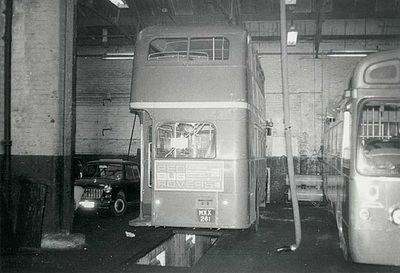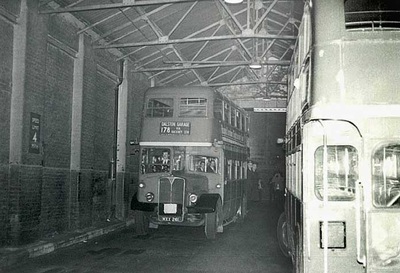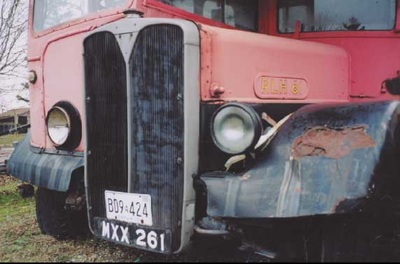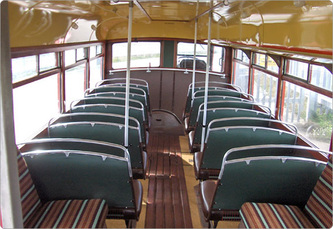Recent Photos
Older Photos
|
RLH61
Seating Capacity:
53 (27 upstairs and 26 downstairs) Special features: Beautifully restored and very rare. Ideal for film work and weddings. Description:
RLH61 another of our long term projects that we have returned to the road in some style! RLH61 has a history that spans both the UK and Canada, having spent 33 years there mainly in Ontario. The reason for these vehicles being so popular overseas was that they are significantly lower than a normal double decker, which makes this vehicle ideal today for hires that are in areas that have low trees or limited height but where more people need to be carried than on a single deck bus. The buses were built to a very provincial feel and the interior gives off a feel of being older than the bus actually is, with exposed varnished wood and mellow colours. This particular example was the last of this type to ever operate for London Transport back in 1971. Vehicle History
Class History:
The RLH is basically a low height RT, hence the prefix Regent Low Height. London had, up until the war, ran very few low height buses as the Metropolitan Police were convinced the unusual seating arrangement would cause delays in loading times and hold up other traffic unnecessarily. World War II caused a complete re-think of this as extra capacity was required on many routes that passed under low bridges whilst economies were always sought in not running more vehicles than were absolutely necessary due to the fuel rationing and shortages of things like brakes and tyres. During this period London ‘borrowed’ many types from provincial operators some of which were of the low height variety which operated without causing the chaos envisaged in the pre war days. Following hostilities London needed to replace its war weary fleet and this included the few low height double decks actually owned by the Board. To start with 20 were purchased on standard AEC Regent III chassis and bodied by Weymann in 1950, these all went into service in the Country Area in green. To enable the remaining low bridge buses to be replaced a further 56 were ordered in 1952, the first 32 again went for Country use in green, whilst the remainder went into Central Area red (including RLH61). The class continued to operate until 1971 when the final route that could not be diverted round or have the road lowered to allow conventional double decks, the 178’s, was converted to high capacity single decks. Due to their low height configuration many RLH’s were sold overseas for further use, with big buyers being both the USA and Canada. Even today some survive as bars, cafes or restaurants in these countries, whilst here in the UK only 5 remain, of which one is a mobile uniform store that was converted by London Country for this purpose. For more on this class why not visit Ian's Bus Stop RLH61 RLH61 entered service on December 1, 1952 at Harrow Weald where it took up duties on route 230, where it remained until August 1958 where a very short stay saw it operate on the 127’s until the last day of operation by double decks. It then moved back again to Harrow Weald where it worked until going into storage at various depots before eventually ending up Dalston Garage for use on the 178. It remained here until April 1971 when the route became the very last to be operated by the RLH’s and on April 16, RLH61 became the very last of the class to operate on this route and thus bring to an end 20 years of service in London. Many of the RLH’s found quick buyers in the USA and Canada where their low height made them ideal. RLH61 was no exception heading of to the ‘New World’ in the summer of 1971 destined for Toronto. Various owners operated it on sightseeing duties in Ottawa and Kingston, before passining into private ownership in the early 1990’s where its condition gradually deteriorated.By 2004 the vehicle was in the last chance saloon as the elements took their toll and its long term home was due to be sold and the vehicle was left facing oblivion. Purchased by Ensignbus, its acquisition was kept secret from the Chairman and the vehicle was repatriated, recovered and restored without his knowledge, eventually being presented to him as a late birthday gift in July 2005. Since then it has been a regular performer at many events and still wears its Ontario number plate proudly alongside its UK one as a reminder of its long stint overseas. Technical Specifications: Date of first registration: 1st December 1952 Chassis: AEC Regent III Chassis Number: 9613E6984 Body: Weymann low bridge 2RLH Engine: AEC 9.6 Fuel: Diesel Length: 25’ 11” Seating capacity: 53 seats (27 downstairs & 26 upstairs) |


































